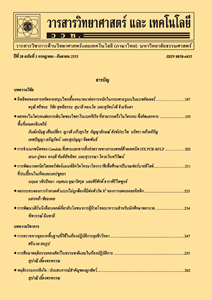ความแปรปรวนทางพันธุกรรมสำหรับปริมาณสารต้านอนุมูลอิสระและความสามารถในการต้านอนุมูลอิสระของข้าวพื้นเมือง 20 สายพันธุ์ ที่มีลักษณะทางการเกษตรที่ดี
Main Article Content
บทคัดย่อ
การค้นหาเชื้อพันธุกรรมที่มีความแปรปรวนทางพันธุกรรมสูงเป็นขั้นตอนสำคัญสำหรับการปรับปรุงพันธุ์ข้าวเพื่อเพิ่มคุณค่าทางอาหาร ดังนั้นการศึกษาครั้งนี้จึงมีวัตถุประสงค์เพื่อประเมินความแปรปรวนทางพันธุกรรมสำหรับปริมาณสารต้านอนุมูลอิสระและความสามารถการต้านอนุมูลอิสระในข้าวพื้นเมือง 20 สายพันธุ์ ซึ่งปลูกทดสอบจาก 2 สถานที่ คือ แปลงทดลอง สาขาวิชาเทคโนโลยีการเกษตร มหาวิทยาลัยธรรมศาสตร์ จังหวัดปทุมธานี และแปลงอนุรักษ์พันธุ์ข้าวพื้นเมือง จังหวัดอบุลราชธานี ผลการศึกษาพบว่าอิทธิพลของสายพันธุ์ สถานที่ทดสอบ และปฏิสัมพันธ์ระหว่างสายพันธุ์กับสถานที่ทดสอบมีความแตกต่างกันทางสถิติในทุกลักษณะที่ศึกษา โดยอิทธิพลของสายพันธุ์ส่งผลต่อปริมาณสารประกอบฟีนอลิคทั้งหมด ปริมาณฟลาโวนอยด์ทั้งหมด และความสามารถในการต้านอนุมูลอิสระด้วยวิธี ABTS สูงที่สุด คิดเป็นร้อยละ 59.07, 76.58 และ 66.85 ของความแปรปรวนทั้งหมด ตามลำดับ ขณะที่สถานที่ทดสอบมีอิทธิพลต่อความสามารถในการต้านอนุมูลอิสระด้วยวิธี DPPH (ร้อยละ 94.13 ของความแปรปรวนทั้งหมด) นอกจากนี้สายพันธุ์ TU-123, TU-130, TU-145 และ TU-148 มีการปรับตัวได้กว้างสำหรับปริมาณสารต้านอนุมูลอิสระและความสามารถในการต้านอนุมูลอิสระ ดังนั้นสายพันธุ์ข้าวที่มีศักยภาพสูงเหล่านี้จะถูกคัดเลือกเพื่องานปรับปรุงพันธุ์ต่อไปในอนาคต
Article Details
References
Food and Agricultural Organization of the United Nations, Rice is Life, Available source: http://www.fao.org/rice2004/en/p17.htm, October 25, 2017.
Watchararparpaiboon, W., Laoakunjit, N. and Kerdchoechuen, O., 2010, An improved process for high quality and nutrition of brown rice production, Food Sci. Technol. Int. 16: 147-158.
Chakuton, K., Puangpronpitag, D. and Nakornriab, M., 2012, Phytochemical content and antioxidant activity of colored and non-colored Thai rice cultivars, Asian J. Plant Sci. 11: 283-293.
Chen, X.Q., Nagao, N., Itani, T. and Irifune, K., 2012, Anti-oxidative analysis and identification and quantification of anthocyanin pigments in different colored rice, Food Chem. 135: 2783-2788.
Moko, E.M., Purnomo, H., Kusnadi, J. and Ijong, F.G., 2014, Phytochemical content and antioxidant properties of colored and non-colored varieties of rice bran from Minahasa, North Sulawesi, Indonesia, Int. Food Res. J. 21: 1053-1059.
Tsao, R., 2010, Chemistry and biochemistry of dietary polyphenols, Nutrients 2: 1231-1246.
Sompong, R., Siebenhandl-Ehn, S., Linsberger-Martin, G. and Berghofer, E., 2011, Physicochemical and antioxidative properties of red and black rice varieties from Thailand, China, and Sri Lanka, Food Chem. 124: 132-140.
Suttana, W., 2013, Anticancer activities of flavonoids: Mechanisms of actions, Srinagarind Med. J. 28: 567-569. (in Thai)
Pupaka, D., 2016, Rice landraces diversity for developing products of food supplements and functional Foods in Chachoengsao province, KKU Sci. J. 44(3): 566-578. (in Thai)
Yamuangmorn, S. and Prom-u-thai, C.T., 2016, Variation of anthocyanin content and antioxidant capacity among local Thai purple glutinous rice genotype, J. Agri. 32(2): 191-199. (in Thai)
Boonsit, P., Pongpichan, P., Julsrigival, S. and Karladee, D., 2010, Gamma-oryzanol content in glutinous purple rice landrace varieties, CMU. J. Nat. Sci. 9(1): 151-157. (in Thai)
Harakotr, B., Prompoh, K., Boonyuen, S., Suriharn, B. and Lertrat, K., 2019, Variability in nutraceutical lipid content of selected rice (Oryza sativa L. spp. indica) germplasms, Agronomy 9(12): 823.
Rerkasem, B. and Rerkasem, K., 2002, Agrodiversity for in situ conservation of Thailand’s native rice germplasm, CMU. J. 1: 129-148.
Shen, Y., Jin, L., Xiao, P., Lu, Y. and Bao, J., 2009, Total phenolics, flavonoids, antioxidant capacity in rice grain and their relations to grain color, size and weight, J. Cereal Sci. 49: 109-111.
Prompoh, K., Harakotr, B. and Suriharn, B., 2020, Evaluation of rice grain morphological characteristics and lipid compounds using multivariate classification techniques, Thai Sci. Technol. J. 28(7): 1253-1266. (in Thai)
Sutharut, J. and Sudarat, J., 2012, Total anthocyanin content and antioxidant activity of germinated colored rice, Int. Food Res. J. 19(1): 215-221.
Folin, O. and Ciocalteu, V., 1927, On tyrosine and tryptophan determinations in proteins, J. Biol. Chem. 73: 627-650.
Kubola, J., Siriamornpun, S. and Meeso, N., 2011, Phytochemicals, vitamin C and sugar content of Thai wild fruits, J. Agric. Food Chem. 126: 972-981.
Harakotr, B., Suriharn, B., Tangwongchai, R., Scott, M.P. and Lertrat, K., 2014, Anthocyanins and antioxidant activity in colored waxy corn at different maturation stages, J. Funct. Foods 9: 109-118.
Gomez, K.A. and Gomez, A.A., 1984, Statistical Procedures for Agricultural Research, John Wiley and Sons, New York, 680 p.
Kim, J.K., Lee, S.Y., Chu, S.M., Lim, S.H., Suh, S.C., Lee, Y.T., Cho, H.S. and Ha, S.H., 2010, Variation and correlation analysis of flavonoids and carotenoids in Korean pigmented rice (Oryza sativa L.) cultivars, J. Agric. Food Chem. 58(24): 12804-12809.
Goffman, F.D. and Bergman, C.J., 2004, Rice kernel phenolic content and its relationship with antiradical efficiency, J. Sci. Food Agric. 84: 1235-1240.
Joralee, A., 2013, Yield, yield components and gamma oryzanol content of black glutinous rice (Oryza sativa L.) grown under various environmental conditions, Master Thesis, Khon Kaen University, Khon Kaen, 103 p. (in Thai)
Kesarwani, A., Chiang, P.Y. and Chen, S.S., 2014, Distribution of phenolic compounds and antioxidative activities of rice kernel and their relationships with agronomic practice, Sci. World J. 2014: 1-6.
Lur, H.S., Hsu, C.L., Wu, C.E., Lee, C.Y., Lao, C.L., Wu, Y.C., Chang, S.J., Wang, C.S. and Kondo, M., 2009, Changes in temperature, cultivation timing and grain quality of rice in Taiwan changes in temperature, cultivation timing and grain quality of rice in Taiwan in recent years, Crop Environ. Bioinform. 6: 175-182.

